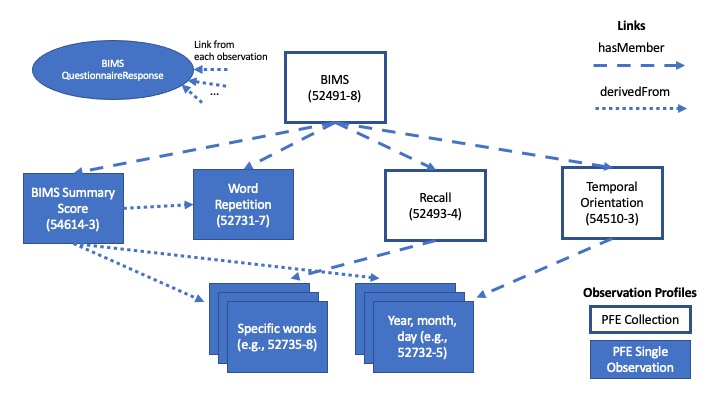PACIO Personal Functioning and Engagement Implementation Guide, published by HL7 International / Patient Care. This guide is not an authorized publication; it is the continuous build for version 2.0.0 built by the FHIR (HL7® FHIR® Standard) CI Build. This version is based on the current content of https://github.com/HL7/fhir-pacio-pfe/ and changes regularly. See the Directory of published versions
| Page standards status: Informative |
In many cases, clinicians use formal, structured instruments to capture details on a patient's functioning and engagement. These include:
The Structured Data Capture FHIR IG provides a methodology for capturing this information within FHIR both in its raw and in its discrete structured form. This page provides guidance on how tools like the SDC Questionnaire and US Core QuestionnaireResponse resources MAY be used with this IG.
Standardized instruments fall into two broad categories based on use of standardized code systems.
Representative examples of each of these categories are provided in the following sections to guide implementers.
The following are examples of fully codified assessments. QuestionnaireResponse representations of these assessments can be fully mapped to structured observation resources defined in this IG.
| Tool | LOINC Codes |
|---|---|
| ASHA NOMS Functional Communication Measure - Swallowing panel | 99852-6 NOMS Functional Communication Measure (FCM): Swallowing 99853-4 What modified diet is recommended for the individual to swallow solids safely? 99854-2 What modified liquid is recommended for the individual to swallow safely? 99855-9 What percentage of the individual's daily diet is delivered through non-oral means in order to maintain adequate nutrition and hydration? 99856-7 How often does the individual exhibit difficulties with oral containment or secretion management? 99857-5 How often does the individual require supervision/assistance at meal time due to swallowing safety? 99858-3 Functional Communication Measure - Swallowing score [ASHA NOMS] |
| Brief Interview for Mental Status (BIMS) (QuestionnaireResponse) | 52491-8 Brief Interview for Mental Status (example) 52731-7 Repetition of Three Words. Number of words repeated after first attempt (example) 54510-3 Temporal Orientation (orientation to year, month, and day) (example) 52732-5 Able to report correct year (example) 52733-3 Able to report correct month (example) 54609-3 Able to report correct day of the week (example) 52493-4 Recall (example) 52735-8 Able to recall "sock" (example) 52736-6 Able to recall "blue" (example) 52737-4 Able to recall "bed" (example) 54614-3 BIMS Summary Score (example) |
| Self-care subset of MDS v3.0 - RAI v1.17.1, 1.17.2 - Interim Payment Assessment (IPA) item set [CMS Assessment] | 90540-6 Self-Care - Interim Performance 95019-6 Eating 95018-8 Oral hygiene 95017-0 Toileting hygiene |
Not all assessment tools have standardized codes for all of their questions. For example. the MoCA has a coded representation for the summary score, not the individual questions. In cases like this, QuestionnaireResponses MAY not be fully mapped to structured observations, meaning that some information remains only in the QuestionnaireResponse instance, or on the paper form.
| Montreal Cognitive Assessment (MoCA) (QuestionnaireResponse) | 72133-2 Montreal Cognitive Assessment [MoCA] (example) 72172-0 Total score [MoCA] (example) |
When representing formal assessments with complex structures as FHIR Observations, each panel and question SHALL be mapped to an individual Observation instance, with panels represented using the collection profile and questions represented using the single observation profile. Two kinds of links between the observation instances capture important relationships:
hasMember element.derivedFrom element. Note that these derivation links appear in this element alongside references to any QuestionnaireResponse that the set of Observations is generated from. The two uses of the derivedFrom element can be distinguised by the resource type: score derivations links point to Observation instances, while the reference to the complete instrument response will point to a QuestionnaireResponse.This diagram illustrates the required and suggested structure and linkages using the Brief Interview for Mental Status (BIMS) as an example. Note that this structure may be embedded within a larger formal assessment, such as an MDS Assessment described above.

Following the structure of the LOINC codes representing the BIMS, the following structures and links are involved:
hasMember element.derivedFrom element to the individual questions used to calculate the score (e.g., 52732-5).derivedFrom element.